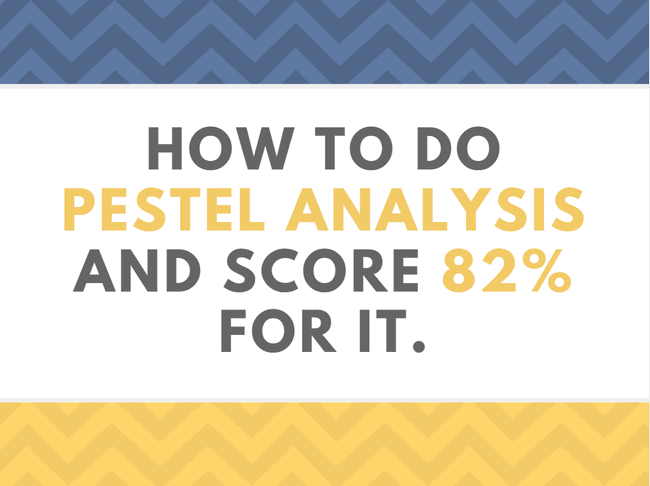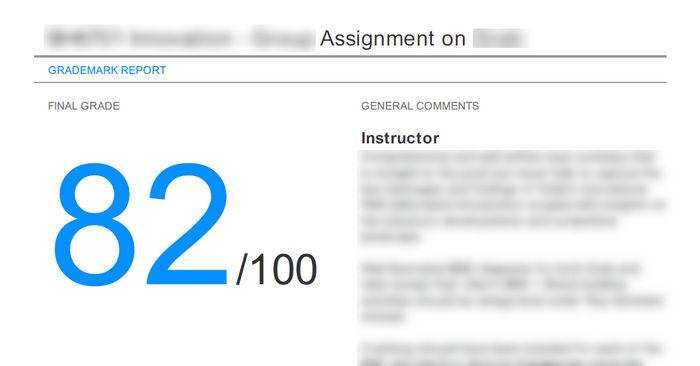
Recently, one of our writers did a 2,500 words assignment that includes PESTEL analysis (or PESTLE analysis) for a customer.
The customer loves it. He subsequently scored 82% for his individual assignment.

While 82 is not perfect, the score is the best in class and significantly higher than the 2nd best score in class, which is 74.
It is through hard work and experience that we are able to consistently produce work at a similar level as this.
In this blog post, we will share with you some tips on how to ace your PESTEL analysis. First though, let us go through the fundamentals of it.
What is PESTEL analysis?
PESTEL analysis looks at a country’s general environment to determine whether it is favourable for a company/industry to operate in and if there are anything that the company can do to align itself towards the environment.
It is an acronym for Political, Economic, Social, Technological, Environmental and Legal.

Political: It looks at how a government can affect the economy or a certain industry. This includes:
- How stable is the government?
- Did the government introduce any new tax or duty that will affect the company/industry?
- What are the tax policies?
Economic: It looks at the health of the economy and other factors affecting it. Some examples are:
- How is the economy? Is it growing or having a recession?
- What is the inflation rate? Does it lower consumers’ buying power?
- How is the foreign exchange performing? Is the local currency raising against others?
Social: This scrutinises the social environment of the country. The culture and trends that are embraced by the society as a whole.
- Are consumers health-conscious?
- Are consumers increasingly buying through online channels?
- What is the population structure? Is it an ageing demographics?
- Is disposable income increasing?
Technological: This pertains to the technology and innovation state of the country that may affect the industry/company.
- What is the internet penetration rate?
- How are consumers using technology in a way that affects the industry/company?
- What is the mobile penetration rate?
- How fast is the internet?
Environmental: This include factors such as the climate, weather and geographical location. Increasingly, factors such as climate change, environmental awareness of the public and government’s environmental stance, are included as part of this environment.
- How is the climate in the country?
- What is the government stance on environmental issues?
- Are there many natural disasters occurring in the country?
Legal: This refers to the relevant laws that affect the industry/company.
- Employment law
- Discrimination law
- Antitrust law
Tip #1: Whenever possible, look for recent trends in the country.

Even though PESTEL analysis is in fact, looking at the current and probable short-term future environment, many students tend to miss out on mentioning trends that are occurring in the country. Through the years, we realise that PESTEL analysis that includes recent trends are almost always going to score high points.
For example, the introduction of the diesel duty of $0.10/litre in Singapore is a recent trend that may be affecting the industry you are analysing. The GST increase from 5% to 7% in 2007 is not considered recent. It may not even be considered a factor since it is implemented a long time ago and the society should have adjusted to it by now.
Make sure that your factors stay as current as possible.
Tip #2: Avoid non-relevant trends at all cost

Let’s say you are analysing the soft drinks industry in Singapore and you discover that obesity rate is rising in the country. While there is a linkage between drinking soft drinks and the rise in obesity rate, it does not really affect the industry directly.
What is more suitable to discuss on is if there are any measures that the government has placed to prevent the rising obesity rate. This may be in the form of education, by educating students on the dangers of sugar-sweetened beverages, or policies that discourage the consumption of soft drinks.
Tip #3: Not supporting claims with evidence

This usually happens when the student understands the market too well. If you are a Singaporean, you may encounter such a problem when analysing the local market.
For example, you probably think that Singaporeans are for sure getting more xenophobic and you duly list it down under ‘Social Environment’ as one of the factors.
But is there any proof to it?
Or you’d think that Singaporeans are complain kings or kiasu. Again, can you proof this with evidence?
Remember that even social stigmas must be supported by evidence.
PESTEL Analysis Example
Bringing everything together, here is a short example of PESTEL analysis for Uniqlo operating in the Singapore market.
(Psss.. Are you interested to have your PESTEL analysis done by us? Click here!)
Take note that citations are not included in the below example but will be provided for any PESTEL analysis work that you pass to us.
Political
Government support for enterprises (Opportunity) – The Singapore Government continues to adopt business-friendly policies which has seen the country consistently ranked as one of the top global destinations for ease of doing business. This can also be seen in its stimulus package during the COVID19 pandemic, where more than $100 billion has been made available to support business and economic activities.
Economic
Long recovery expected for economy (Opportunity and Threat) – COVID19 has a severe impact not only on Singapore’s economy, but also the country’s key trading partners. With a historical GDP contraction of 6.2% in 2020, it is expected that the economy will take a long time to recover to pre-COVID19 levels. While this resulted in poor consumer sentiment, it may benefit businesses that adopted cost-leadership strategy, such as Uniqlo.
Socio-cultural
Online shopping habits (Opportunity) – Increasingly, Singaporeans have switched to online shopping as e-commerce industry grow 23% in 2020. It is forecasted that the industry will continue to grow at a rate of 7% every year, to be worth SGD2.4 billion annually in 2030.
Technology
Age of 5G Network (Opportunity) – With 5G network expected to be implemented countrywide by 2022, numerous technology such as Internet-of-things (IoT) will be commonplace.
Environment
Global warming – Global warming has seen temperature in Singapore rise by 1.1 degree over the past 20 years. According to IMDA, hot weather has increased the popularity of lighter clothing using ‘beathe-able’ materials.
Environmental Consciousness – Sustainability has also become more popular as consumers are increasingly conscious about the environmental impact they made. Sustainable clothing has therefore become the latest trend, with consumer groups around the world demanding the use of garments and processes that are sustainable.
Conclusion
PESTEL analysis is not difficult if you know what you are doing. It requires a lot of effort and time to find the relevant trends that affect the industry/company. This is especially difficult if you are researching a foreign country that you have little or no knowledge on, such as Nigeria or Kazakhstan.
Nonetheless, with perseverance and the information presented in this blog post, you should be able to get it done with quality.

2 Comments
-

Hi, do you do PEST analysis for Singapore company? I want a local to do this since local knows better Singapore company.
-
Author
Hi there! Sure we do. We are Singapore-based and have local writers that can provide the ‘local’ knowledge needed for your assignment.
Leave a reply
You must be logged in to post a comment.


